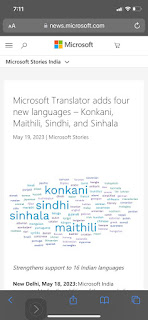CONTRIBUTE VOICE CLIPS TO MICROSOFT TRANSLATOR
GO TO https://translator.microsoft.com/
Download
Microsoft Translator APP- (Android/ IOS)
Click three
horizontal lines in the left top corner.
Click “on”
to Contribute Voice Clips to contribute clips to teach Microsoft’s speech
technology more about Maithili.
Your contribution
start confirmation date/ time appears, which could be sent to your email too.
……………….
https://www.bing.com/translator
https://translator.microsoft.com/
The development of Maithili was championed by Dr. Girish
Nath Jha from the Jawaharlal Nehru University (JNU) New Delhi, who provided
critical test sets and initial training data.
Microsoft Translator adds four new languages – Konkani, Maithili, Sindhi, and
Sinhala
https://news.microsoft.com/en-in/microsoft-translator-adds-four-new-languages-konkani-maithili-sindhi-and-sinhala/
Strengthens support to 16 Indian languages
New Delhi, May 18, 2023: Microsoft India announced today the addition of three
new Indian languages Konkani, Maithili, and Sindhi, in Microsoft Translator.
Along with this, Microsoft Translator will also support Sinhala, the official
language of Sri Lanka. With this latest release, Microsoft is further
democratizing access to information in native languages for India. Microsoft Translator
now supports 16 Indian languages: including Assamese, Bengali, Gujarati, Hindi,
Kannada, Konkani, Maithili, Malayalam, Marathi, Nepali, Odia, Punjabi, Sindhi,
Tamil, Telugu, and Urdu.
Microsoft Translator will now allow over 95% of Indians to access information
and work in their native or preferred languages, making computing
language-agnostic and more inclusive in India. It can help general users
interpret real-time conversations, menus, street signs, websites, and
documents. Companies can leverage it to globalize their business and strengthen
customer outreach. Microsoft Translator can be used across Windows, iOS,
Android, and the web. Microsoft also continues to push the boundaries on the
quality of translations across Indian languages.
The function is available on the Microsoft Translator app, edge browser, Office
365, Bing Translator, and through the Azure Cognitive Services Translator API
for businesses and developers. Users can translate Konkani, Maithili, Sindhi,
and Sinhala text, supported in more than 125 languages, for their apps,
websites, workflows, and tools with Azure Cognitive Services Translator.
Businesses can also avail multi-language support such as translation for
e-content, e-commerce product catalogues, product documentation, and internal
communication, among others.
Konkani is spoken by over 2 million people in India, primarily in the states of
Goa, Maharashtra, and Karnataka. It is also spoken by a significant number of
people in other parts of India, such as Kerala and Gujarat. Maithili is spoken
by over 75 million people in India and Nepal. It is the second most widely
spoken language in the Indian state of Bihar and is also spoken in the
neighboring states of Jharkhand and West Bengal. The development of Maithili
was championed by Dr. Girish Nath Jha from the Jawaharlal Nehru University
(JNU) New Delhi, who provided critical test sets and initial training data.
Sindhi is spoken by over 20 million people in India, and several other
countries in the subcontinent while Sinhala is spoken by over 16 million people
in Sri Lanka, as well as in other countries such as Malaysia and Singapore.
Rajiv Kumar, managing director, Microsoft India, said, “At Microsoft we are
committed to empower every individual and organization on the planet and this
commitment is reflected in our attempt to broaden the reach of technology and
inclusiveness through language as a medium. We are excited to announce that we
are broadening our language capabilities to include Maithili, Konkani, Sindhi,
and Sinhala. We celebrate and support India’s diversity of language and culture
with the most advanced AI to enable India’s growth, by making access to
technology pervasive. “
Bringing Deep Neural Networks to language translation
Microsoft has been using Deep Neural Networks to develop language models for
translating and transliterating complex Indian languages. Deep Neural Networks
are also sensitive to minor linguistic nuances such as gender (feminine,
masculine, neutral), politeness level (slang, casual, written, formal), and
word type (verb, noun, adjective). Microsoft continuously improves the
translation models in line with tech advancement, usage, and releases newer,
improved versions to all its users in a transparent manner.
About Microsoft India
Microsoft (Nasdaq “MSFT” @microsoft) enables digital transformation for the era
of an intelligent cloud and an intelligent edge. Its mission is to empower
every person and every organization on the planet to achieve more. Microsoft
set up its India operations in 1990. Today, Microsoft entities in India have
over 20,000 employees, engaged in sales and marketing, research, development,
and customer services and support, across 11 Indian cities – Ahmedabad,
Bengaluru, Chennai, New Delhi, Gurugram, Hyderabad, Kochi, Kolkata, Mumbai,
Noida, and Pune. Microsoft offers its global cloud services from local data
centers to accelerate digital transformation across Indian startups,
businesses, and government organizations.



